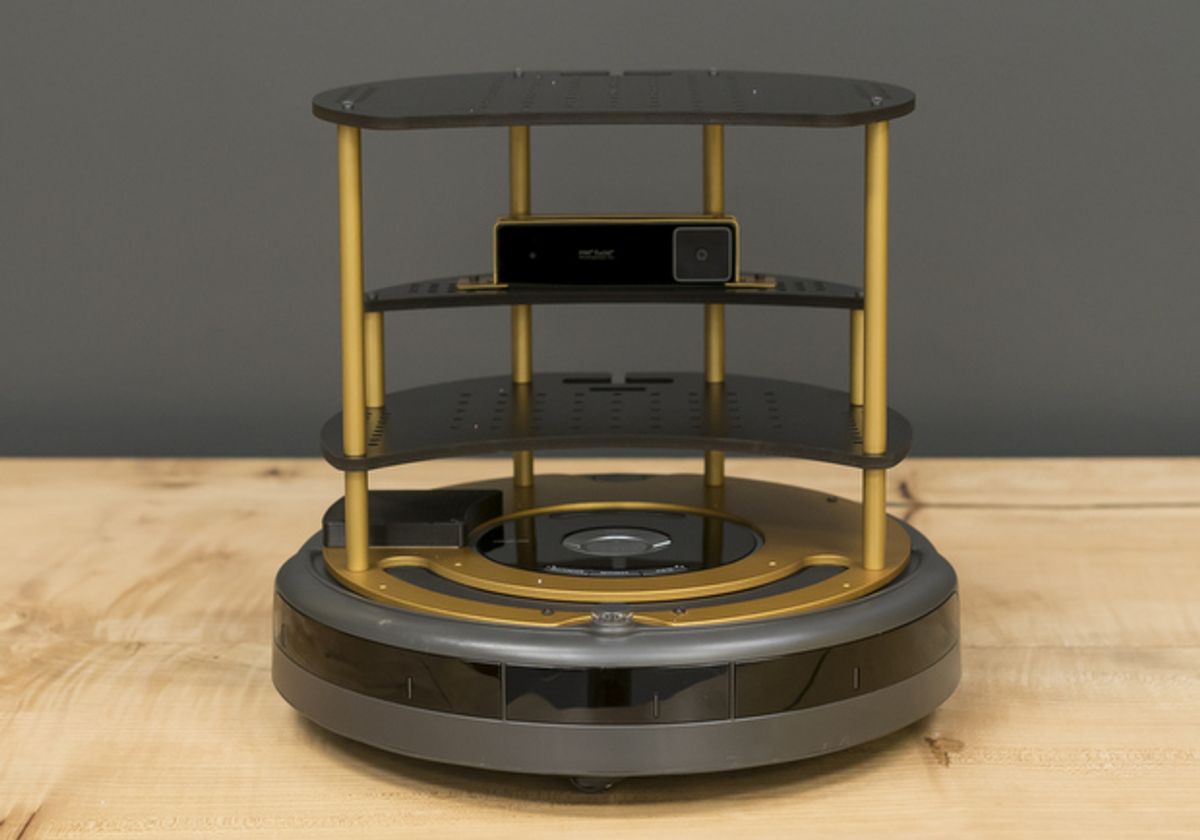Today, Clearpath Robotics (in partnership with Intel and iRobot) is announcing the newest member of the TurtleBot family: the TurtleBot Euclid. The TB Euclid, which should probably not be abbreviated as TBe, features an iRobot Create 2 mobile base along with a shiny new Intel Euclid sensing and computing module. It’s designed to be both easier to use and cheaper than the original Turtlebot 2, and makes us more certain than ever that yes, TurtleBots are taking over the world.
It’s no secret that we love TurtleBots. We love big TurtleBots, and we love little Turtlebots, but we especially love TurtleBots that are brand new, and that makes TurtleBot Euclid our absolute favorite right now.
The first thing you’ll notice is that the TBe swaps out the TB2’s Kobuki mobile base for an iRobot Create 2. You may recall that Kobuki was specifically designed to be the perfect mobile base for the Turtlebot 2 and as such comes with all kinds of switches and buttons and ports and whatnot, but for many users (especially new users), all of that stuff is overkill that adds to the cost of the base, making the overall robot more expensive.
The Create 2 is cheaper than Kobuki, and (according to Clearpath) is also more robust, which does make some amount of sense, since Create 2s are made from remanufactured Roombas, some of the beefiest robots out there— mine have thrown themselves down staircases and survived with just a few scratches. You also get built-in automatic docking (another Roomba feature), and better battery options.
The second thing that you’ll notice is that the TBe uses the Intel Euclid to replace the TB2’s netbook and Kinect, making the robot much cleaner and simpler without the wild tangle o’ cables that thrive on the TB2. Euclid integrates a calibrated RealSense ZR300 depth camera with a computer built around a quad core Atom processor and Ubuntu 16.04 (with ROS Kinetic Kame pre-installed), all in a bite-sized little package in glossy piano black. The RealSense camera is IR-based, with a 3.5-meter texture projector-enhanced range indoors and a longer range outdoors, and provides robust 3D spatial perception for object detection and mapping.
Since Euclid doesn’t come with a keyboard or screen, Intel has designed and implemented a custom software layer on top of Ubuntu and ROS that allows you to control and program the robot using a web interface on any phone or computer, no extra software required. This means no separate linux computer that you have to SSH into that acts as a ROS master, and if you don’t know enough about ROS to understand any of that, well, that’s one of the big reasons why TurtleBot Euclid is worth getting excited about, says Clearpath:
Turtlebot Euclid takes the difficulty out of robotics networking and integration. The unit arrives pre-assembled, with software installed. There’s no need to worry about compatibility with your laptop, as the programing environment remains on the Euclid. Users can access the development environment through a web-interface from any device, so there’s no need to specify additional hardware. Turtlebot Euclid is the easiest way to get started with ROS.
This is the big difference between Turtlebot Euclid and Turtlebot 2, and the reason why both robots will peacefully co-exist going forward. If you’re an experienced ROS user looking for a platform that you can add a bunch of sensors or other hardware to, and you want to be able to do lots of onboard development and other complicated robotics stuff, you’ll probably still want a TB2. If you want to do practical things with ROS without having to worry about hardware compatibility or software setup, then you’ll want to go with Turtlebot Euclid. And if you just want a capable ROS platform at an absolute minimum of size and cost, Turtlebot 3 is where it’s at.
Turtlebot Euclid is expected to retail for around US $1440, shipping included. For comparison, a Turtlebot 2 is $1925, and a Turtlebot 3 (Burger model) is $550. Of the cost of the Turtlebot Euclid, $400 is in Euclid itself, a Create 2 will run you $200, and Clearpath has added a custom low-level microcontroller between the two. You also get all of the mechanical parts, of course, and a portion of the cost goes towards supporting the Open Source Robotics Foundation (yay!).
The rest of your TBe investment goes towards lovingly polite hand assembly and testing of each robot by a team of certified Canadians and (among other things) the massive amount of effort that Clearpath has already put in, and will be continuing to put in, to make TBe as reliable and user friendly as possible. This includes a comprehensive series of tutorials, guides, simulations, and demos that should help students (of all ages) learn robotics through ROS.
Turtlebot Euclid will be officially launching at IROS in Vancouver next month, but ROSCon is the weekend before, and I bet you’ll be able to get a peek at one there, too. And if you like what you see and want to pre-order a Turtlebot Euclid before IROS, you’ll be getting one in a snazzy custom gold color along with a pre-sale price of $1152.
Evan Ackerman is a senior editor at IEEE Spectrum. Since 2007, he has written over 6,000 articles on robotics and technology. He has a degree in Martian geology and is excellent at playing bagpipes.






